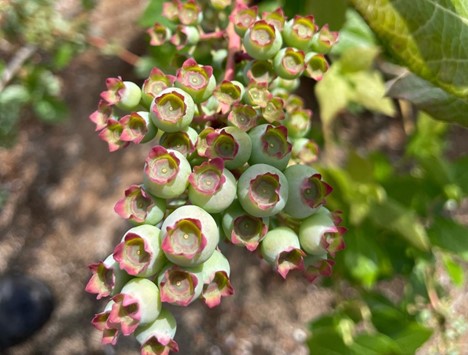July 3, 2023
By Victoria Marsh, Western Technical Sales Agronomist
I believe we all have opened a pack of blueberries we just bought and about halfway down the carton you find a few shriveled and a few super squishy, berries. Most people throw those unwanted fruits in the trash/compost and don’t ever think about them again. But for those of you who have wondered what causes that berry to shrivel/bloat in such a specific way, this article may clear some things up for you.
What you, and anyone else that has eaten blueberries, most likely saw was the physiological effect on the blueberry fruit that the Botrytis cinerea (Botrytis) fungi cause. Botrytis can affect the blueberry bush at several stages and the blossom blight stage often causes the most loss of yields. Immature fruits that become infected with the fungi will shrivel and turn a blueish purple, if a ripe blueberry is affected it will turn tan and become soft.
Often Botrytis’ life cycle is misunderstood due to the inconsistent annual damage it can cause. But, regardless of the extent of the damage the fungi are generally present on the plant every year. However, it will not cause damage unless the right weather conditions are present. Botryius can only cause severe injury during cool, wet periods that last several days in duration. This has to coincide with the bloom and shoot growth timings. The optimal temperature for infection is 61-68 degrees. The fungi will overwinter on twigs and dead crop debris, then in the spring produce wind-dispersed spores that are moved to blooms or new shoots. The younger the plant/tissue the more likely infection will occur.

No one wants Botrytis to strike, so there are a lot of methods used for control. Pruning to open the canopy for better penetration of light, air, and spray is a great way to battle these fungi. Avoiding excessive nitrogen is a great way to reduce a dense canopy and thus lower the risk of infection. Harvesting consistently and often will also limit the amount of overripe and susceptible berries. And lastly, the use of crop protection products is also a necessary step toward getting adequate protection.
Like in any crop protection program rotation, several Modes of Action (MOA) for your fungicides are important for resistance management. One product to put into your spray program in AZterknot. AZterknot is a great option for the suppression of Botrytis, as well as the dual MOA: Azoxystrobin and a biological extract, Reynoutria sachalinensis extract. Both act as plant health promoters so you can protect your plant against fungi while also helping boost growth and yields.
As blueberries are my favorite fruit, I would just like to say a big thank you to all the blueberry farmers out there! And to all farmers of any crop. Thanks for feeding your communities, the USA, and the world.
